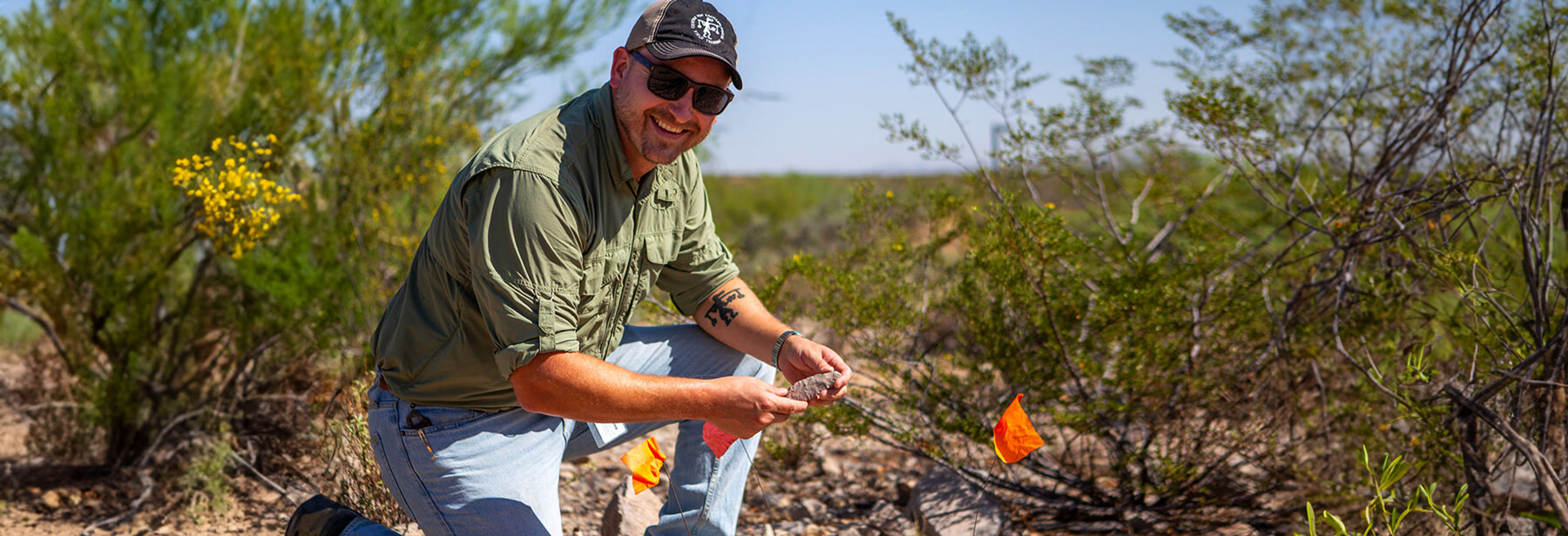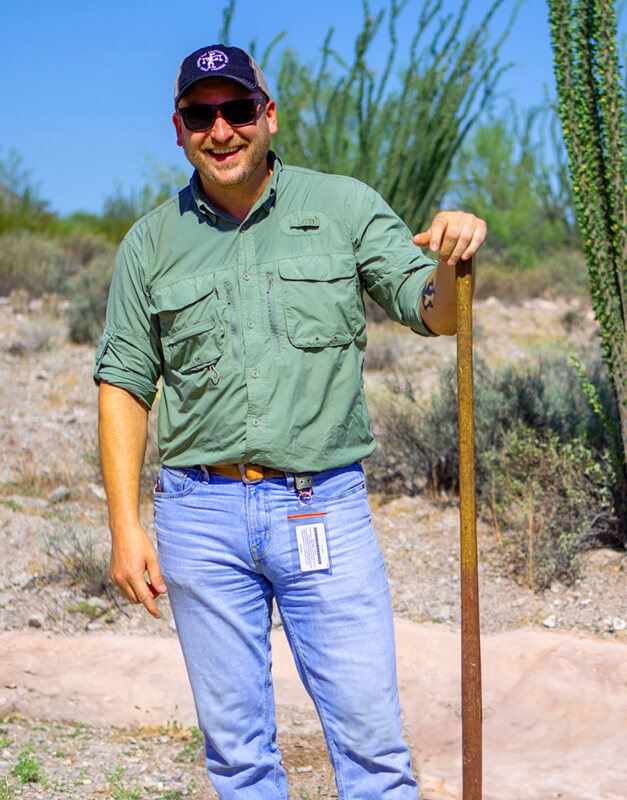
Georgia Native, Pima Alum Finds His Calling on Archaeology Staff
By Dina Doolen, External Relations
In 2011, when Ehren (pronounced like Aaron) Keltz was 24 and working as a contractor in North Miami Beach, Florida, he realized what he wanted to do with his life – become an archaeologist.
That realization led him to move across the country to Tucson. Now, he is lab supervisor at the Pima Community College Centre for Archaeology Field Training, based at West Campus.
“I was in the hotel room, reading a National Geographic article and it just hit me, ‘Wow! People do this for a living!’” he says, explaining that he had thought archaeology was a profession made up for the movies or one that no longer existed.
“Once I realized I could do it for a living, I immediately decided I wanted to go back to school.” He did an internet search for best archaeology schools in the U.S., and the University of Arizona was at the top of the results.

On the phone with a UA advisor, he learned that he would pay expensive out-of-state tuition if he enrolled there right after moving to Tucson. She suggested he start at Pima, which she noted had a good archaeology program, then transfer to UA. He hesitated before accepting her advice
"In January of 2012, on my 25th birthday, I loaded up a moving truck and moved out to Tucson,” says Keltz, who grew up near Stone Mountain, Georgia, and was living in Atlanta. “I started school at Pima and nearly instantly fell in love with the Pima Archaeology Centre faculty and staff. Additionally, I have fallen in love with the Sonoran Desert and Tucson.”
“Pima’s archaeology program puts a lot of universities to shame,” he says.
He paid for Pima using a combination of financial aid, his own savings, his parents’ college fund for him and pay from part-time jobs while at Pima.
The late Lea Mason-Kohlmeyer was Keltz’s inspiration. She died in 2022.
“She had a particular way of teaching and interacting with students that really spoke to me,” he says. “I learned more from her than probably any other individual instructor.”
Keltz graduated Pima in summer 2015 with an Associate of Arts-Anthropology (Archaeology concentration) and an Arizona General Education Curriculum-Arts, then enrolled at Northern Arizona University in Flagstaff.
“Pima’s archaeology program puts a lot of universities to shame. ”
“Everyone who was teaching here at the time says, ‘Go to NAU,’” he says. “Their reasoning was that UA is more classical focused, but NAU was more focused on Southwest archaeology,” which he was focused on.
He earned bachelor’s and master’s degrees at NAU, doing archaeology work with NAU graduate students, then EnviroSystems Management, Inc., of Flagstaff.
Starting when he was at NAU, Keltz regularly attended the Pecos Conference, a southwest archaeology conference, where he would talk with Archaeology Center program coordinator Helen O’Brien. He started thinking about working at Pima.
O’Brien recalled a conversation they had about five years ago at the conference when Keltz was extremely happy and told her he had just started a new private sector job after working at Grand Canyon National Park.
In August 2023, they again ran into each other at the conference. She encouraged him to apply for an open job at the Archaeology Centre. Within a couple of months, he was back in Tucson.
“I cannot think of a better fit for the Archaeology Centre and its students,” O’Brien says.
Keltz regularly works with Pima faculty member Mary Prasciunas, Ph.D., in her field archaeology surveying and excavation classes. Every semester he guides students on surveys and excavations at various sites in Pima County and surrounding regions.
“Ehren is a fantastic addition to our team. Students love working with him,” Prasciunas says. “His warmth, friendly personality and good sense of humor make learning fun and allow students to feel comfortable right away.”
“PCC set me on my personal and career paths because I could actually afford it. I also love the diversity at a community college that you don’t get at a university. That is a beautiful thing. ”
In May 2024, Keltz was the keynote speaker at Pima’s 15th Annual Arizona Undergraduate Research Symposium. He used ancient spear points and arrowheads as an indicator of growth and decline of populations at the Grand Canyon. By comparing fluctuations in the types of points found to climate changes around the Colorado Plateau and Grand Canyon over the past 13,000 years, he showed that when it got hotter, there was a decline in the number of specific types of points, indicating fewer people lived there.
“I hope to be as inspiring to the next generation of archaeologists,” says Keltz, who “failed out” of community college when he enrolled right after high school.
“PCC set me on my personal and career paths because I could actually afford it,” he says. “I also love the diversity at a community college that you don’t get at a university. PCC has people from all ethnic, racial and cultural backgrounds and of all ages. That is a beautiful thing.”
Explore careers in the social sciences
From pursuing an interest in field archaeology to understanding different facets of people and societies – their histories interactions, strengths, frailties, weaknesses, stories – Pima has something to offer.
Explore our degrees and certificates today.
Found something you like? Apply Now